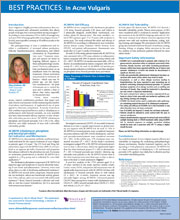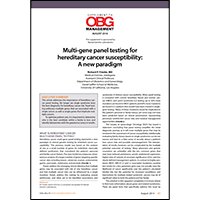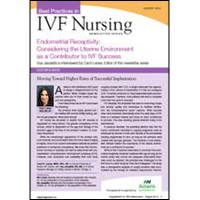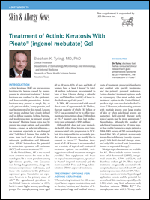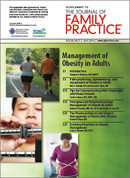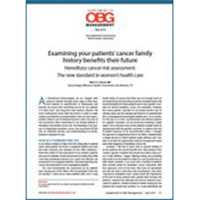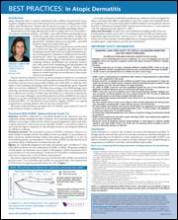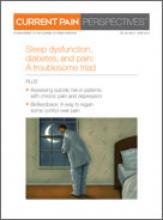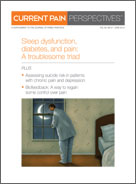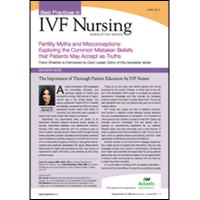User login
BEST PRACTICES IN: Acne Vulgaris
A Best Practices Supplement to Skin & Allergy News®. This supplement was sponsored by Valeant Dermatology, a division of Valeant Pharmaceuticals.
- Introduction
- ACANYA (clindamycin phosphate and benzoyl peroxide) Gel Indication and Mechanisms
- ACANYA Gel Efficacy
- ACANYA Gel Tolerability
- IMPORTANT SAFETY INFORMATION
Faculty/Faculty Disclosures
Hilary Baldwin, MD
SUNY Downstate Medical Center
Brooklyn, NY
Dr. Baldwin discloses that she serves as a member on the advisory board for Valeant Pharmaceuticals.
Copyright © by Frontline Medical Communications Inc.
A Best Practices Supplement to Skin & Allergy News®. This supplement was sponsored by Valeant Dermatology, a division of Valeant Pharmaceuticals.
- Introduction
- ACANYA (clindamycin phosphate and benzoyl peroxide) Gel Indication and Mechanisms
- ACANYA Gel Efficacy
- ACANYA Gel Tolerability
- IMPORTANT SAFETY INFORMATION
Faculty/Faculty Disclosures
Hilary Baldwin, MD
SUNY Downstate Medical Center
Brooklyn, NY
Dr. Baldwin discloses that she serves as a member on the advisory board for Valeant Pharmaceuticals.
Copyright © by Frontline Medical Communications Inc.
A Best Practices Supplement to Skin & Allergy News®. This supplement was sponsored by Valeant Dermatology, a division of Valeant Pharmaceuticals.
- Introduction
- ACANYA (clindamycin phosphate and benzoyl peroxide) Gel Indication and Mechanisms
- ACANYA Gel Efficacy
- ACANYA Gel Tolerability
- IMPORTANT SAFETY INFORMATION
Faculty/Faculty Disclosures
Hilary Baldwin, MD
SUNY Downstate Medical Center
Brooklyn, NY
Dr. Baldwin discloses that she serves as a member on the advisory board for Valeant Pharmaceuticals.
Copyright © by Frontline Medical Communications Inc.
Multi-gene panel testing for hereditary cancer susceptibility: A new paradigm
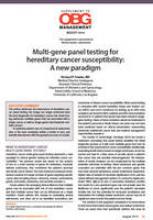
Click here to download the PDF.
EXECUTIVE SUMMARY
This article addresses the importance of hereditary cancer panel testing. No longer are single syndrome tests the best diagnostic for hereditary cancer risk. Panel testing addresses multiple genes that are associated with a single cancer, as well as single genes that implicate multiple cancers.
To optimize patient care, it is important to determine who is the best candidate within a family to test, and identify laboratories with the greatest accuracy in results.
Medical Director, Intelegene
Assistant Clinical Professor

Click here to download the PDF.
EXECUTIVE SUMMARY
This article addresses the importance of hereditary cancer panel testing. No longer are single syndrome tests the best diagnostic for hereditary cancer risk. Panel testing addresses multiple genes that are associated with a single cancer, as well as single genes that implicate multiple cancers.
To optimize patient care, it is important to determine who is the best candidate within a family to test, and identify laboratories with the greatest accuracy in results.

Click here to download the PDF.
EXECUTIVE SUMMARY
This article addresses the importance of hereditary cancer panel testing. No longer are single syndrome tests the best diagnostic for hereditary cancer risk. Panel testing addresses multiple genes that are associated with a single cancer, as well as single genes that implicate multiple cancers.
To optimize patient care, it is important to determine who is the best candidate within a family to test, and identify laboratories with the greatest accuracy in results.
Medical Director, Intelegene
Assistant Clinical Professor
Medical Director, Intelegene
Assistant Clinical Professor
Best Practices in IVF Nursing: Endometrial Receptivity: Considering the Uterine Environment as a Contributor to IVF Success
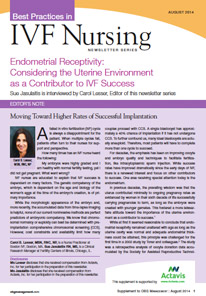
Click here to download the PDF.
A failed in vitro fertilization (IVF) cycle is always a disappointment for the patient. When multiple cycles fail, patients often turn to their nurses for support and perspective.
How many times has an IVF nurse heard the following:
My embryos were highly graded and I am healthy with normal fertility testing, yet I did not get pregnant. What went wrong?

Click here to download the PDF.
A failed in vitro fertilization (IVF) cycle is always a disappointment for the patient. When multiple cycles fail, patients often turn to their nurses for support and perspective.
How many times has an IVF nurse heard the following:
My embryos were highly graded and I am healthy with normal fertility testing, yet I did not get pregnant. What went wrong?

Click here to download the PDF.
A failed in vitro fertilization (IVF) cycle is always a disappointment for the patient. When multiple cycles fail, patients often turn to their nurses for support and perspective.
How many times has an IVF nurse heard the following:
My embryos were highly graded and I am healthy with normal fertility testing, yet I did not get pregnant. What went wrong?
Treatment of Actinic Keratosis With Picato® (ingenol mebutate) Gel – A New Supplement
Topics
- Introduction
- Treatment Options for Actinic Keratosis
- Treatment With Picato Gel
- Sequential Treatment With Cryosurgery and Picato Gel
- Talking With Patients About Picato Gel
- Conclusions
Faculty
Stephen K. Tyring, MD, PhD
Clinical Professor
Departments of Dermatology, Microbiology and Immunology, and Internal Medicine
University of Texas Health Science Center
Houston, Texas
Dr. Tyring discloses that he has conducted clinical research and given presentations sponsored by LEO Pharma Inc., the manufacturer of Picato®.
Topics
- Introduction
- Treatment Options for Actinic Keratosis
- Treatment With Picato Gel
- Sequential Treatment With Cryosurgery and Picato Gel
- Talking With Patients About Picato Gel
- Conclusions
Faculty
Stephen K. Tyring, MD, PhD
Clinical Professor
Departments of Dermatology, Microbiology and Immunology, and Internal Medicine
University of Texas Health Science Center
Houston, Texas
Dr. Tyring discloses that he has conducted clinical research and given presentations sponsored by LEO Pharma Inc., the manufacturer of Picato®.
Topics
- Introduction
- Treatment Options for Actinic Keratosis
- Treatment With Picato Gel
- Sequential Treatment With Cryosurgery and Picato Gel
- Talking With Patients About Picato Gel
- Conclusions
Faculty
Stephen K. Tyring, MD, PhD
Clinical Professor
Departments of Dermatology, Microbiology and Immunology, and Internal Medicine
University of Texas Health Science Center
Houston, Texas
Dr. Tyring discloses that he has conducted clinical research and given presentations sponsored by LEO Pharma Inc., the manufacturer of Picato®.
Management of Obesity in Adults
More than one-third of adults and one-sixth of children and adolescents in the United States are obese (ie, body mass index [BMI] ≥30 kg/m2).1 This is more than double the prevalence in 1994).2 Also of great concern, is that the prevalence of extreme obesity (BMI ≥40 kg/m2) rose from 3.9% to 6.6% in the United States from 2000 to 2010, a 70% increase.3 As primary care providers, family physicians contend on a daily basis with cardiovascular and other health consequences of this burgeoning epidemic.
More than one-third of adults and one-sixth of children and adolescents in the United States are obese (ie, body mass index [BMI] ≥30 kg/m2).1 This is more than double the prevalence in 1994).2 Also of great concern, is that the prevalence of extreme obesity (BMI ≥40 kg/m2) rose from 3.9% to 6.6% in the United States from 2000 to 2010, a 70% increase.3 As primary care providers, family physicians contend on a daily basis with cardiovascular and other health consequences of this burgeoning epidemic.
More than one-third of adults and one-sixth of children and adolescents in the United States are obese (ie, body mass index [BMI] ≥30 kg/m2).1 This is more than double the prevalence in 1994).2 Also of great concern, is that the prevalence of extreme obesity (BMI ≥40 kg/m2) rose from 3.9% to 6.6% in the United States from 2000 to 2010, a 70% increase.3 As primary care providers, family physicians contend on a daily basis with cardiovascular and other health consequences of this burgeoning epidemic.
Examining your patients’ cancer family history benefits their future
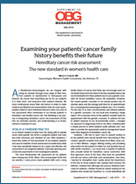
Click here to download the PDF.
As Obstetrician-Gynecologists, we are charged with caring for women through every stage of their lives. From puberty to reproduction to menopause and beyond, we ensure that everything we do for our patients is in their short- and long-term best medical interests. We must continuously assess their risk factors in order to make medical and lifestyle recommendations that are most appropriately suited to each individual woman's need. One area of risk assessment often overlooked in our female patients is hereditary and familial cancer risk. The following is my journey of integrating hereditary cancer risk assessment (HCRA) into my everyday practice, and understanding it as fundamental to standard of care.

Click here to download the PDF.
As Obstetrician-Gynecologists, we are charged with caring for women through every stage of their lives. From puberty to reproduction to menopause and beyond, we ensure that everything we do for our patients is in their short- and long-term best medical interests. We must continuously assess their risk factors in order to make medical and lifestyle recommendations that are most appropriately suited to each individual woman's need. One area of risk assessment often overlooked in our female patients is hereditary and familial cancer risk. The following is my journey of integrating hereditary cancer risk assessment (HCRA) into my everyday practice, and understanding it as fundamental to standard of care.

Click here to download the PDF.
As Obstetrician-Gynecologists, we are charged with caring for women through every stage of their lives. From puberty to reproduction to menopause and beyond, we ensure that everything we do for our patients is in their short- and long-term best medical interests. We must continuously assess their risk factors in order to make medical and lifestyle recommendations that are most appropriately suited to each individual woman's need. One area of risk assessment often overlooked in our female patients is hereditary and familial cancer risk. The following is my journey of integrating hereditary cancer risk assessment (HCRA) into my everyday practice, and understanding it as fundamental to standard of care.
BEST PRACTICES IN: In Atopic Dermatitis
Medical Education Library
A Best Practices Supplement to Skin & Allergy News®. This supplement was sponsored by Valeant Pharmaceuticals North America LLC.
- Introduction
- Treatment with ELIDEL ® (pimecrolimus) Cream 1%
- IMPORTANT SAFETY INFORMATION
Faculty/Faculty Disclosure
Dr. Adelaide A. Hebert, MD
University of Texas Medical School at Houston
Houston, Texas
Dr. Hebert reported that she has served as a consultant and speaker for Astellas Pharma US, Inc.; Novartis Pharmaceuticals Corporation; and Valeant Pharmaceuticals, North America, LLC. Her employer, the University of Texas Health Sciences Center-Houston has received grant funding for research conducted by Dr. Hebert for Astellas and Novartis.
Copyright © by Frontline Medical Communications Inc.
Medical Education Library
A Best Practices Supplement to Skin & Allergy News®. This supplement was sponsored by Valeant Pharmaceuticals North America LLC.
- Introduction
- Treatment with ELIDEL ® (pimecrolimus) Cream 1%
- IMPORTANT SAFETY INFORMATION
Faculty/Faculty Disclosure
Dr. Adelaide A. Hebert, MD
University of Texas Medical School at Houston
Houston, Texas
Dr. Hebert reported that she has served as a consultant and speaker for Astellas Pharma US, Inc.; Novartis Pharmaceuticals Corporation; and Valeant Pharmaceuticals, North America, LLC. Her employer, the University of Texas Health Sciences Center-Houston has received grant funding for research conducted by Dr. Hebert for Astellas and Novartis.
Copyright © by Frontline Medical Communications Inc.
Medical Education Library
A Best Practices Supplement to Skin & Allergy News®. This supplement was sponsored by Valeant Pharmaceuticals North America LLC.
- Introduction
- Treatment with ELIDEL ® (pimecrolimus) Cream 1%
- IMPORTANT SAFETY INFORMATION
Faculty/Faculty Disclosure
Dr. Adelaide A. Hebert, MD
University of Texas Medical School at Houston
Houston, Texas
Dr. Hebert reported that she has served as a consultant and speaker for Astellas Pharma US, Inc.; Novartis Pharmaceuticals Corporation; and Valeant Pharmaceuticals, North America, LLC. Her employer, the University of Texas Health Sciences Center-Houston has received grant funding for research conducted by Dr. Hebert for Astellas and Novartis.
Copyright © by Frontline Medical Communications Inc.
Current Pain Perspectives—June 2014
Best Practices in IVF Nursing: Fertility Myths and Misconceptions: Exploring the Common Mistaken Beliefs that Patients May Accept as Truths
The Importance of Thorough Patient Education by IVF Nurses
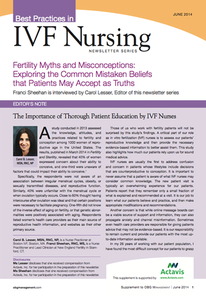
Click here to download the PDF.
A study conducted in 2013 assessed the knowledge, attitudes, and practices related to fertility and conception among 1000 women of reproductive age in the United States. The results, published in March 2014 in Fertility and Sterility, revealed that 40% of women expressed concern about their ability to conceive, and one-third were unaware of factors that could impact their ability to conceive.
The Importance of Thorough Patient Education by IVF Nurses

Click here to download the PDF.
A study conducted in 2013 assessed the knowledge, attitudes, and practices related to fertility and conception among 1000 women of reproductive age in the United States. The results, published in March 2014 in Fertility and Sterility, revealed that 40% of women expressed concern about their ability to conceive, and one-third were unaware of factors that could impact their ability to conceive.
The Importance of Thorough Patient Education by IVF Nurses

Click here to download the PDF.
A study conducted in 2013 assessed the knowledge, attitudes, and practices related to fertility and conception among 1000 women of reproductive age in the United States. The results, published in March 2014 in Fertility and Sterility, revealed that 40% of women expressed concern about their ability to conceive, and one-third were unaware of factors that could impact their ability to conceive.

